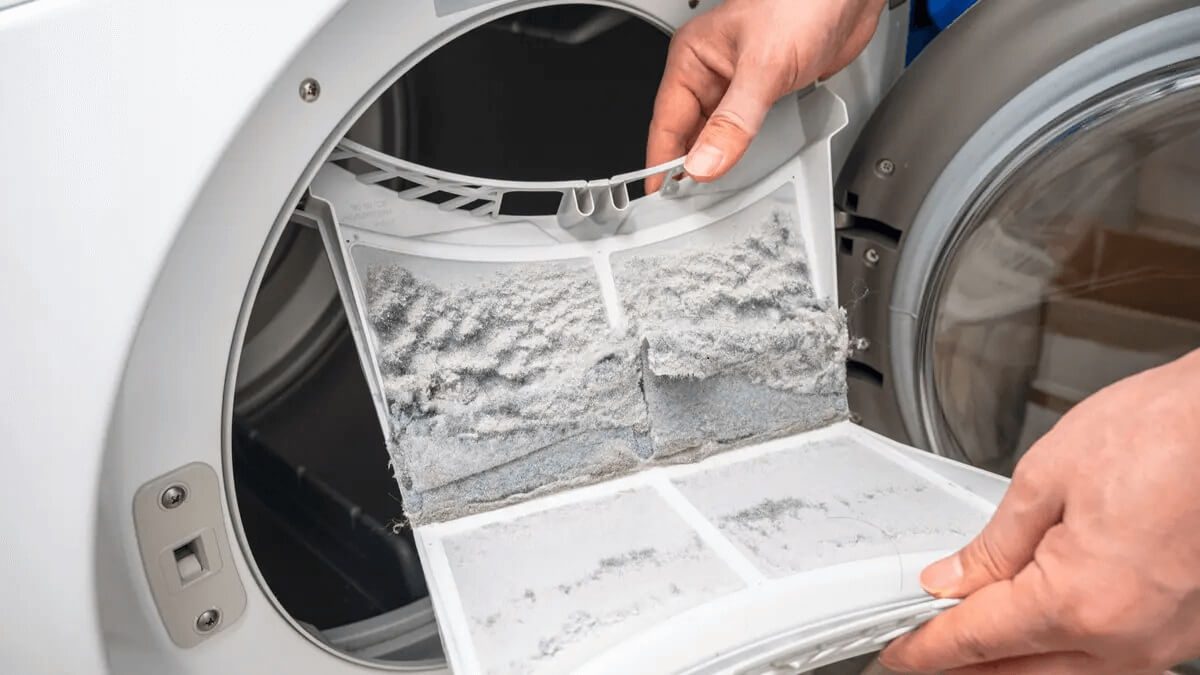A lint trap is a component of the clothes dryer that filters the air vented out during the drying circle by trapping the lint in that air. It is important to clean the dryer duct and exhaust hose to maintain optimal dryer performance and prevent fire hazards. Without that lint filter, excessive amounts of lint […]

A lint trap is a component of the clothes dryer that filters the air vented out during the drying circle by trapping the lint in that air. It is important to clean the dryer duct and exhaust hose to maintain optimal dryer performance and prevent fire hazards. Without that lint filter, excessive amounts of lint would build up in the dryer vent hose, causing harm to the dryer’s efficiency and life span, and increasing the risk of fire. You need to clean the dryer’s lint trap between every batch of clothes, and in this article, we will provide you with some pointers to make this job easier.
Cleaning the dryer lint trap is not just a routine chore; it’s a crucial maintenance task that can prevent dryer fires, improve dryer performance, and reduce energy bills. The lint trap captures and collects lint, fibers, and other debris that can accumulate and cause problems. Failure to clean the lint trap can lead to a buildup of lint, which can ignite and cause a fire. In fact, according to the U.S. Fire Administration, dryer fires cause around $35 million in property loss each year. Regular cleaning of the lint trap can help prevent these fires and ensure your dryer runs efficiently. By keeping the lint trap clean, you not only protect your home but also enhance the longevity and efficiency of your dryer.
So where does the lint trap lie on a dryer? Depending on the make and the model of the dryer, the location of the filter may vary. Typically, you may find it at the following locations:

Front load dryers have the lint traps just behind the door (Source: Internet)

Top-filter dryers have the lint traps on top of the dryer (Source: wikihow)
In order to devise the best way to clean the dryer’s lint filter, you should first learn what are the things that may build up on the part. As it turns out, what often deposits on the lint screen is not just the lint; the residual fabric softener also gets trapped on the screen, creating a film that you may not see with plain eyes. Regular cleaning of the dryer’s lint filter is crucial for maintaining dryer safety and efficiency, as it helps prevent fires caused by lint buildup.
To clean the dryer’s filter, you’ll need some preparations. The tools to clean the dryer’s filter consist of the following:
It is surprising how much lint can accumulate in the dryer and its venting system, emphasizing the need for regular cleaning.
Clean the lint screen by following these simple steps:

Wash the lint screen with hot water, dish soap and a soft-bristle brush (Source: Internet)
You’ll have to rinse and repeat this process multiple times until the film of the residual fabric softener gets completely cleaned up. To make sure that the screen is fully cleaned up, drop some water drops on the lint and see whether the water goes through the screen easily. If not, then you have to wash the screen again.
Another way to do this is to fill the sink with hot water enough for the lint filter to soak, pour in some dish soap/vinegar, and do the washing and brushing in that water. Again, check to see whether the water passes through the screen easily. Once it does, meaning that the film of fabric softener residual has got cleaned up, rinse the screen again with normal water.
As for how often you should clean the dryer lint filter, you should do it after every drying batch. Though the good news is, that it does get a lot easier for each attempt when you do it frequently. And your dryer gets healthier from that too.
Step 3: Leave the lint trap to air dry completely before reattaching it to the dryer
While regular cleaning of the lint trap is essential, sometimes a deeper clean is necessary to remove stubborn residue and lint that may have accumulated over time. To deep clean the lint trap, start by locating and removing it from your dryer. Use a nylon brush and hot water to scrub away any residue and lint. A bit of dish soap can help break down any fabric softener buildup. Rinse the lint trap thoroughly with hot water and dry it with a clean towel. For an even more thorough clean, you can use a vacuum cleaner to remove any remaining debris. Once the lint trap is completely dry, reassemble it and insert it back into the dryer. This deep cleaning process ensures that your lint trap is free from any blockages, allowing your dryer to operate at peak efficiency.
Despite how we wish for the lint problem to be solved just by washing the filter, it is simply not. The truth is, while being reduced by the filter, the lint does get past the lint screen and might accumulate in other places inside the dryer, and the filter slot underneath the lint screen is the place where it accumulates the most.
Before any cleaning attempt, you should first unplug the dryer in order to not get zapped, as you may need to unbolt some screws.
To clean the dryer’s filter slot, once you have removed the lint screen, you may use an extended vacuum cleaner to snake inside the slot and vacuum the lint out. The problem with this method is that not every lint filter slot can fit in a vacuum hose, and also that you don’t have a lot of control over the process. So for a better deep clean, you may need to take the lint filter slot out from the dryer.

Remove the lint trap slot from the dryer to clean the lint inside (Source: Internet)
Depending on the type of dryer, the lint trap compartment can be accessed by either removing the front or the backplate of the dryer. For the top-filter dryer, a.k.a the type of dryer with the lint trap on a corner of the top plate near the control, it would be at the back. And for the front-load dryer, a.k.a. the ones with the lint traps just behind the dryer’s door, you’ll have to remove the front plate. Be prepared to remove a lot of screws. Also, be careful with the wires, as dryers may have wired devices attached to the plate; you’ll have to remove these devices first. In addition, to facilitate the cleaning process, a dryer lint cleaner could come in handy. This tool could help us to reach the smallest area of the dryer.
Once you have opened up the dryer and get access to the lint trap compartment underneath the lint screen slot, take it out. Then remove the lint inside it by hand or with a vacuum cleaner. Then reattach the lint trap slot and rewire and reattach the front/backplate.
Beyond the lint trap slot, the lint may as well pass into the dryer cabinet, causing the components of the machine to work less efficiently and sometimes even leading to fire hazards. So lint must be cleaned before too much builds up.
Additionally, cleaning dryer vents is crucial to maintain appliance functionality and prevent fire hazards. The lint trap and ducts leading outside can accumulate flammable lint and debris, posing risks to safety and efficiency.
To gain full access to the dryer’s cabinet, you will need to remove the dryer’s front plate and the drum. Follow these steps to clean the accumulated lint from the dryer’s cabinet.

Remove the drive belt from the dryer drum (Source: Sears Partsdirect)
Maintaining your dryer’s performance goes beyond just cleaning the lint trap. Regular maintenance of the dryer vent is equally important. Cleaning the lint trap after every cycle can help prevent lint buildup and maintain optimal dryer performance. Additionally, cleaning the dryer vent at least twice a year can help prevent lint buildup and improve airflow. You can use a dryer vent brush to clean the vent and remove any lint or debris that may have accumulated. Regular maintenance can help prevent costly repairs and extend the life of your dryer. By keeping both the lint trap and dryer vent clean, you ensure that your dryer operates efficiently and safely.
As for how often to clean a dryer lint filter, we would recommend cleaning the lint filter after every batch. Regularly cleaning a dryer lint trap is crucial to maintain optimal dryer performance and prevent fire hazards. For a more thorough cleaning that requires taking out the lint filter slot and opening up the dryer’s cabinet, once every 6 months might be sufficient. This should be done in hand with the dryer vent cleaning. Additionally, frequent cleaning is the key to maintaining the machine’s performance and longevity. If not adequately cleaned of lint, the machine might not even be able to dry your batches of clothes. Therefore, increasing risk over the dryer is inevitable, and a clothes dryer fire could happen if a user is unaware of the safety standards.
Common issues with the lint trap include clogs, buildup, and damage. If you notice that your dryer is taking longer to dry clothes or producing more lint than usual, it may be a sign that the lint trap needs to be cleaned. If the lint trap is clogged or damaged, it can cause problems with your dryer’s performance and even lead to a fire. To troubleshoot common issues with the lint trap, start by checking the lint trap for any blockages or damage. If you find any problems, clean or replace the lint trap as needed. Regular inspection and maintenance of the lint trap can help you identify and resolve issues before they become serious problems.
When it comes to cleaning the lint trap, there are a few common mistakes to avoid. First, using water to remove lint can damage the lint trap and cause problems with your dryer’s performance. Instead, use a vacuum cleaner or your hands to remove lint. Second, not cleaning the lint trap regularly can lead to buildup and clogs, which can cause problems with your dryer’s performance and even lead to a fire. Make sure to clean the lint trap after every cycle. Finally, not replacing the lint trap when it is damaged can cause problems with your dryer’s performance and even lead to a fire. If you notice any damage to the lint trap, replace it immediately. By avoiding these common mistakes, you can ensure that your dryer operates safely and efficiently.
This guide to clean the dryer’s lint trap, along with frequent cleaning of the dryer’s exhaust vent, will help you take care of some if not most of the lint problems that your dryer may have. But if these simple fix doesn’t take care of your dryer problems, do consult a professional appliance repair specialist. You can find more DYI cleaning tips and guides at Sparkling and Beyond’s website. We provide professional and affordable for your kitchen and any other part of the house, for any degree of need. Together, let’s keep your home sparkling clean and healthy.

As the admin of Sparkling & Beyond, I bring a wealth of knowledge and passion for excellence in the cleaning industry. With years of experience in providing top-notch cleaning solutions, I am dedicated to sharing valuable insights and tips to help maintain pristine and healthy living environments. My mission is to ensure every home and office we service sparkles with cleanliness and comfort.
![]()